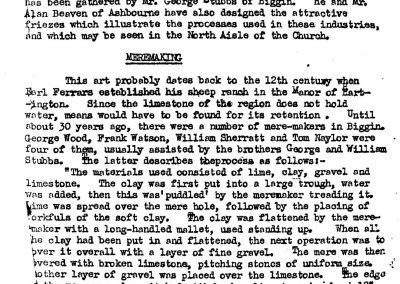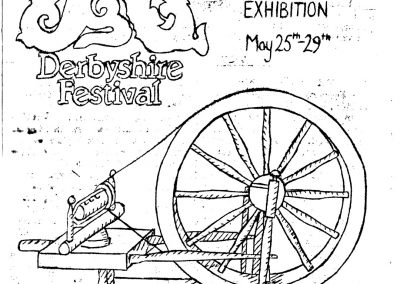News & Views - April 1979 - Issue 5
79 is Derbyshire Festival Year, and the Historical Exhibition of Local Industries and Crafts is part of the parishes of Hartington and. Biggin’s contribution to this County event. It is being held, in St. Giles Church, Hartington, May 25th to 29th, from 11 a.m., until 7 p.m., each day. This issue of News and Views has been prepared, for those visiting the Exhibition and we have tried, to pin-point some of the things we feel you won’ t want to miss. We have also included information about the lesser-known crafts of meremaking and lime-burning. This has been gathered, by Mr. George Stubbs of Biggin. He and Mr. Alan Beaven of Ashbourne have also designed the attractive friezes which illustrate the processes used in these industries, and which may be seen in the North Aisle of the Church.
MEREMAKING
This art probably dates back to the 12th century when Earl Ferrers established his sheep ranch in the Manor of Hartington. Since the limestone of the region does not hold water, means would have to be found for its retention. Until about 30 years ago, there were a number of mere-makers in Biggin. George Wood, Frank Watson, William Sherratt and Tom Naylor were four of them, usually assisted by the brothers George and William Stubbs. The latter describes the process as follows:-
“The materials used consisted of lime, clay, gravel and limestone. The clay was first put into a large trough, water was added, then this was puddled by the meremaker treading it. Lime was spread over the mere hole, followed by the placing of forkfuls of the soft clay, the clay was flattened by the mere- maker with a long-handled mallet, used standing up. When all the clay had been put in and flattened, the next operation was to cover it overall with a layer of fine gravel, the mere was then covered with broken limestone, pitching stones of uniform size, another layer of gravel was placed over the limestone. The edge of the mere was also pitched with broken limestone to about 18″ width; this was to prevent the cattle from treading up the earth ground the mere. This limestone edge was then covered with gravel to prevent the sharp-edged stone cutting the cow’s feet”.
The time book / account book in front of the frieze is. the one used by Frank Watson his father Thomas Watson, Cheapside, Biggin, Frank was the uncle of ‘Jock’ Watson who now lives in the Smithy, Newhaven.
LIME – BURNING
This is a process that consists- of heating limestone so that carbon-dioxide is liberated and quick-line formed. It is recorded as far back as the 13th century, when the lime was used for making mortar for bonding stone, with which castles and town walls were built.
The value of lime as a manure was not discovered until the 16th century. It was then used to improve poor and sour soils, with farmers gathering their own out-crop of stone and burning it in their own pye kiln. It was soon found that there was also a market for this. Next came the running kiln, which meant that the fire never went out, running from one end to the other. The market for lime has gone from strength to strength and has one hundred and one different uses today.
Mr. Percy Allcock of 3, Bankside, Hartington was employed during the 1939-45 war as a lime-drawer, along with his father, in the Hoffman Lime Kiln at Alsop Lime Works. The kiln was shaped like a long endless oval-shaped tunnel. There were two fires burning continuously. One gang of three men were stacking stone in front of the fire and two drawers were fetching it out after the fire had been drawn through it, burning it.
A lime-drawer’s job was to sort out any unburnt stone, which they called “bull heads”, and to knock the lime off them. A good drawer could tell by the “feel”, the stone being heavier than the lime, which lost half its weight in the process of burning. The lime was then loaded into a steel barrow and tipped into railway waggons. Mr. Allcock remarks, the conditions under which we worked would, by today’s standards, be called ‘shocking’. You had to wear clogs, for the heat from the floor would dry boots to pieces. The dust from the lime would burn you when you sweated. All of this for which you were paid 9d per ton. If you had a good day, you would draw around 20 tons”.
+++++++++++
We place on record our thanks to all who have loaned items for the Exhibition, including the County Record Office and Chatsworth House, the organising committee and those who have arranged displays, the stewards and all who have worked in any way for the success of the venture. The proceeds will be divided between Biggin and Harlington Churches.
FINDING YOUR WAY AROUND THE EXHIBITION
As you enter the Church, .please pause and offer a silent Prayer asking God to show us all more clearly the link between worship in church and work in the world.
The Tank Locomotive in front of the Baptistry is a one third full scale model of “J.B.Earle”, one of the two engines which provided motive power on the Leek & Manifold Light Railway, which ran between Hulme End and Waterhouses from 1904 to 1934,
Lime-burning, Meremaking and Dairy Farming are featured in the North Aisle, which leads to the Cheese-making display in the North Transept.
Among the items in the Chancel is information about the Demesne Sheep Flock at Hartington in 1358, the Will and Inventory of a farmer who died at Ludwell in 1684 and an original map of the Manor of Hartington dated 1614, loaned by the Librarian of Chatsworth House.
Biggin and Hartington Schools provide a glimpse of what life was like for a Victorian Child.
Near the Pulpit, Margaret Killips gives demonstrations of Spinning and has hand spindles available, so that you can try your hand at this ancient craft.
Mining and Local Transport, including the Ecton Copper Mines, Railways, Packhorse and Turnpike routes, are featured in the South Transept. In one of the cases is a Miner’s Spade which is at least 200 years old.
Other items of interest include Dry Stone-walling, Brick- -making, House-crafts, the Retail Trade, Tourism and the Work of the Blacksmith. Ancient Documents include Wills and Inventories, Parish Registers, Manor Court Rolls, the Duke of Devonshire’s Rental Accounts for 1752, Land Tax Assessments, Juror’s Books, Deeds, Mortgages, Grants and Sale Catalogues. There is also the Bankruptcy Examination
of a Hartington Butcher and Income Tax returns for 1843.
Before you leave, don’t forget to look at the Bookstall.
Thank you for coming.




